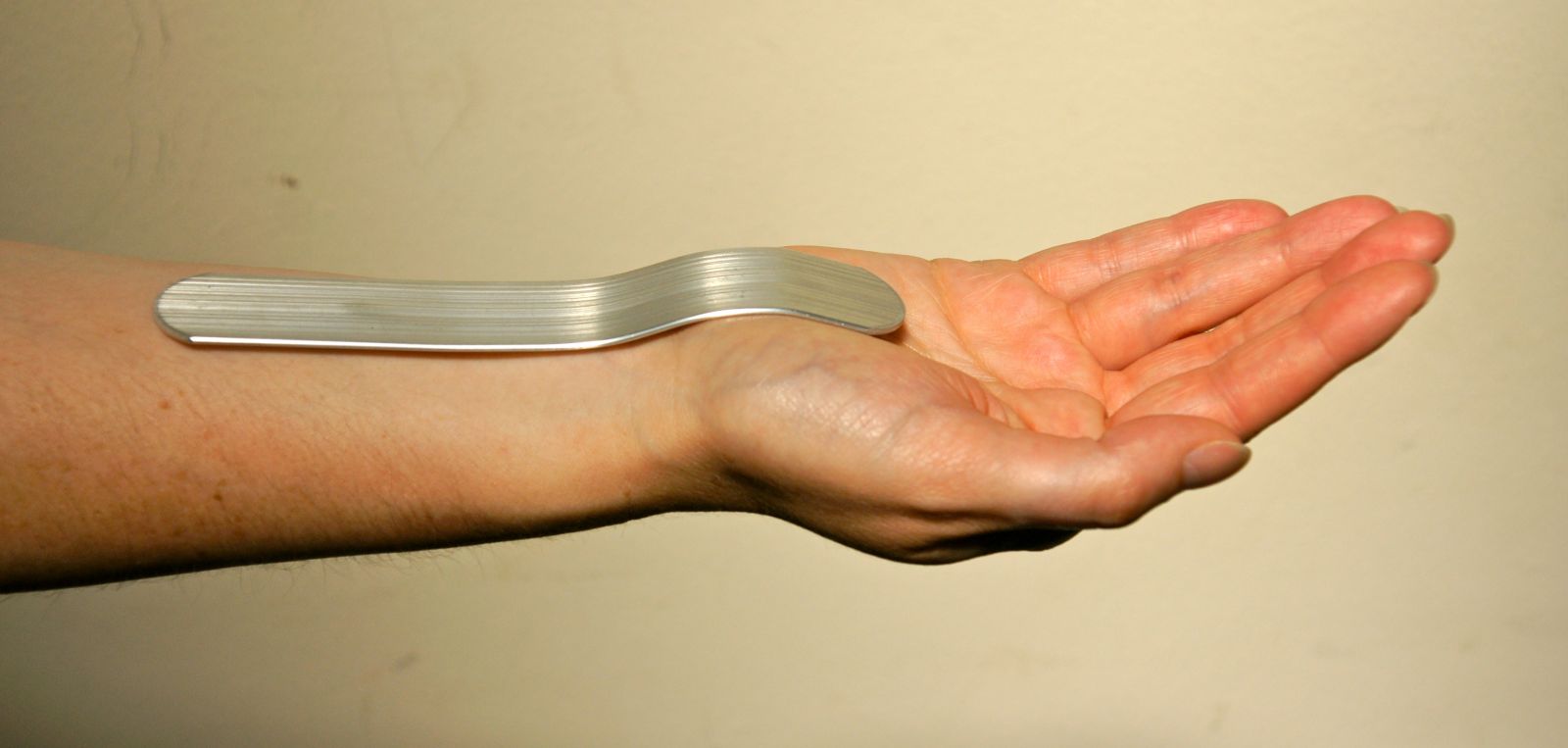Splinting
The general principle of splinting is based upon measurements of carpal tunnel pressure which show it to be markedly influenced by wrist position and hand use. In particular, when the hand is relaxed the pressure is lowest with the wrist in neutral position....

With wrist flexion...
....or extension

......the pressure in the tunnel rises and can easily exceed the blood pressure in the small vessels which supply the median nerve with oxygen. It is perhaps worth noting at this point that the other factor affecting whether blood flow continues in these small vessels is of course the blood pressure at the wrist and that this will vary depending on the position of the hand in relation to the heart. This is probably the explanation for why symptoms tend to appear on raising the hand, as in reading a newspaper, and disappear on lowering it, as in dangling the hand over the side of the bed when awakened by symptoms at night. Splints are designed to hold the wrist in the position where the carpal tunnel pressure is lowest.

The stiff metal support which gives these devices rigidity should be bent specifically to fit YOUR wrist and should be arched over the carpal tunnel area itself so that it does not apply direct pressure to the median nerve from outside. Most designs of splint allow you to remove the metal piece for adjustment and replace it once it is the right shape.

These supports can be worn whenever they do not obstruct activity but most patients settle on only wearing them at night as this is both convenient and also when symptoms are often most troublesome. In the UK splints are fairly readily available over the counter from large chemists and sometimes sports equipment suppliers and they are an ideal initial self-help measure

Many slight variations of splint design are available all of which are designed to achieve the same end of holding the wrist at a particular angle - most commonly neutral though some authors have recommended a few degrees of extension. There is also the strikingly different 'MANU" splint from Italy which is designed to apply transverse compression across the palm while extending the middle and ring fingers and somewhat limiting wrist flexion (Manente 2001). The design principles of this unusual splint are based on a clinical observation that manipulating the hand into this position can transiently relieve paraesthesiae which are present during the clinical examination (Manente 1999). However the two papers describing its use are of poor quality (Manente 2001 and De Angelis 2009).
A further new Italian splint design is currently undergoing early trials in Italy "Carpalello" but needs more extensive study. We are trying to work out how we can test this design in some UK patients. If interested please ask Dr Bland.
In general the quality of evidence available in the scientific literature for the efficacy of splinting is poor and that for particular designs of splint in comparison to each other or for different usage regimens is especially poor to non-existent. For those who wish to see how poor it is, it is comprehensively reviewed in a Cochrane review (O'Connor 2003) which is currently being updated, the latest update concentrating specifically on splinting.
Success rate - There are only a few studies of splinting used alone as a treatment for CTS and the most useful data probably comes from a trial comparing splinting to surgery (Gerritsen 2002). This paper, interestingly, is excluded from the Cochrane reviews of splinting purely because it compares splinting with surgery, not because of any scientific shortcomings - it is actually a very good trial. The way in which this is reported is confusing to those not familiar with trial design and analysis by ‘intention to treat’ but from the published figures one can conclude that 34% of the patients treated with splints did not need other intervention over the course of a year or so of follow up. This is a fairly modest success rate but splints are inexpensive and have no known significant side effects. The popular surgical view is that they are only a palliative measure and that’ no-one wants to wear ugly splints for life’ - but if CTS is sometimes a temporary condition anyway it may not require any more than a temporary fix. There is thus much to be said for an early trial of splinting as soon as symptoms become troublesome.
Almost nothing is known about long-term (longer than 1 year) outcomes after initial treatment with splinting only. The longest reported follow up outside a surgical study comes from a trial which checked up on patients at one year (Werner 2005) after a 6 week period of splinting but this study has several design flaws. For what it is worth the splinting group did somewhat better than the control group who received only 'ergonomic education'.
Unfortunately most UK general practitioners find it difficult or impossible to prescribe splints. They can be purchased over the counter at larger chemists and surgical equipment suppliers if you know what you are looking for and there are also online sources such as Amazon. At present splinting at night is the only intervention which can be recommended for a trial of self treatment without consulting a healthcare professional first.
Splints should be tried for a few weeks. If symptoms are not satisfactorily controlled after 4 weeks of regular night-time use of a correctly fitted splint then it is probably time to start thinking about other treatments. There is no concrete scientific evidence for this recommendation however, just personal opinion based on my experience with patients.
Revision date - 10th November 2020





